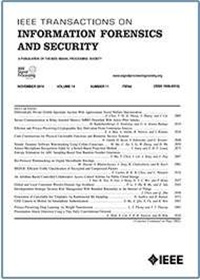RLP-ABE:用于云存储中格的有效用户撤销的可穿刺CP-ABE
IF 8
1区 计算机科学
Q1 COMPUTER SCIENCE, THEORY & METHODS
IEEE Transactions on Information Forensics and Security
Pub Date : 2025-09-22
DOI:10.1109/TIFS.2025.3613055
引用次数: 0
摘要
云计算由于其适应性、成本效益和根据用户需求扩展资源的能力,已成为数据共享的主要平台。确保安全和有效的数据共享长期以来一直是研究的中心焦点,基于属性的加密(ABE)作为关键的加密原语。在实际场景中,用户属性经常发生变化,因此需要及时撤销访问权限。常用的用户撤销方法包括直接撤销和间接撤销。直接撤销由数据所有者控制,数据所有者将撤销信息添加到列表中,并将其嵌入到密文中以撤销权限。间接撤销由授权机构或委托第三方管理,动态发布撤销信息并生成新的密钥和密文。传统的直接和间接撤销方法会产生大量的通信和计算开销,限制了它们的实际有效性,特别是在用户访问频繁终止的环境中。为了解决这些挑战,我们提出了一种新的基于点阵加密的可穿刺密文策略ABE方案,用于用户撤销,消除了密钥再生和撤销列表维护的需要。该方法有效地抵抗共谋攻击、量子攻击和选择明文攻击,实验评估表明其在存储消耗、通信成本和计算开销方面具有优势。本文章由计算机程序翻译,如有差异,请以英文原文为准。
RLP-ABE: Puncturable CP-ABE for Efficient User Revocation From Lattices in Cloud Storage
Cloud computing has become the predominant platform for data sharing due to its adaptability, cost-effectiveness, and ability to scale resources according to user demand. Ensuring secure and efficient data sharing has long been a central research focus, with attribute-based encryption (ABE) serving as a key cryptographic primitive. In real-world scenarios, user attributes often change, necessitating timely revocation of access rights. Common user revocation methods include direct and indirect revocation. Direct revocation is controlled by the data owner, who adds revocation information to a list and embeds it into ciphertext to revoke permissions. Indirect revocation is managed by an authorized authority or delegated third party, dynamically publishing revocation information and generating new keys and ciphertexts. Conventional direct and indirect revocation methods incur substantial communication and computation overheads, limiting their practical effectiveness, particularly in environments with frequent user access terminations. To address these challenges, we propose a novel puncturable ciphertext-policy ABE scheme based on lattice cryptography for user revocation, eliminating the need for key regeneration and revocation-list maintenance. The proposed approach effectively resists collusion, quantum, and chosen-plaintext attacks, and experimental evaluations demonstrate its advantages in storage consumption, communication cost, and computational overhead.
求助全文
通过发布文献求助,成功后即可免费获取论文全文。
去求助
来源期刊

IEEE Transactions on Information Forensics and Security
工程技术-工程:电子与电气
CiteScore
14.40
自引率
7.40%
发文量
234
审稿时长
6.5 months
期刊介绍:
The IEEE Transactions on Information Forensics and Security covers the sciences, technologies, and applications relating to information forensics, information security, biometrics, surveillance and systems applications that incorporate these features
 求助内容:
求助内容: 应助结果提醒方式:
应助结果提醒方式:


